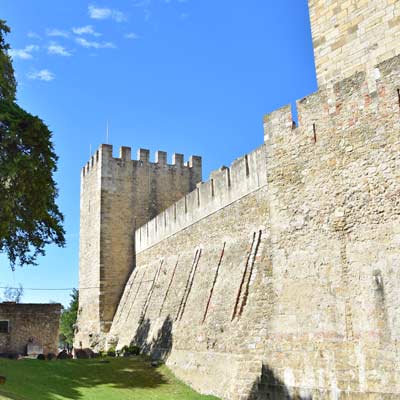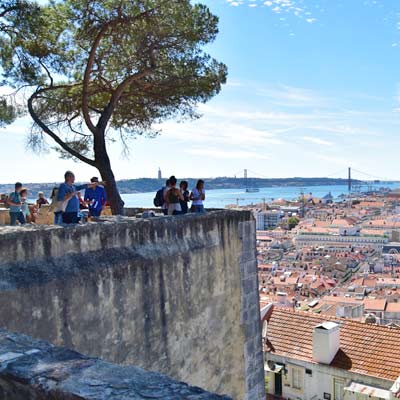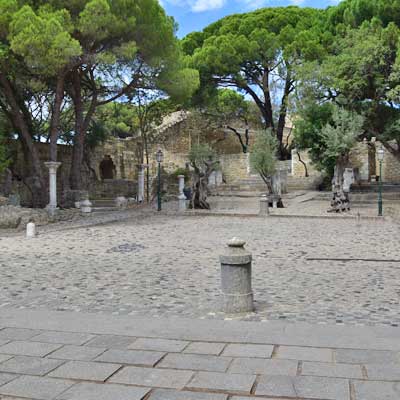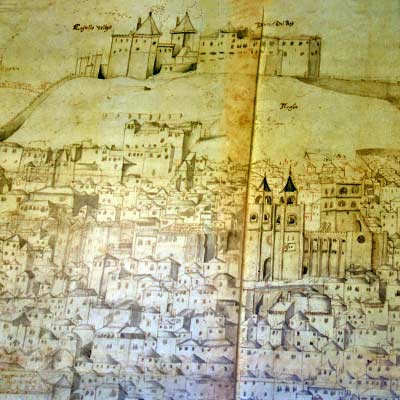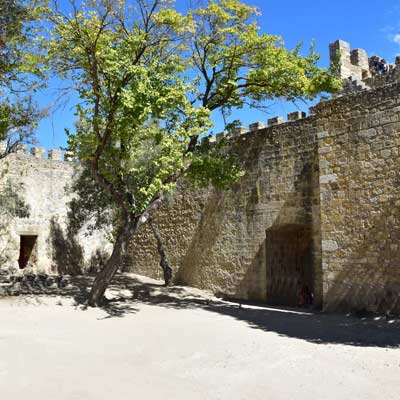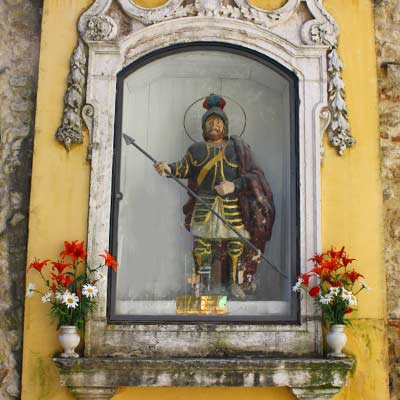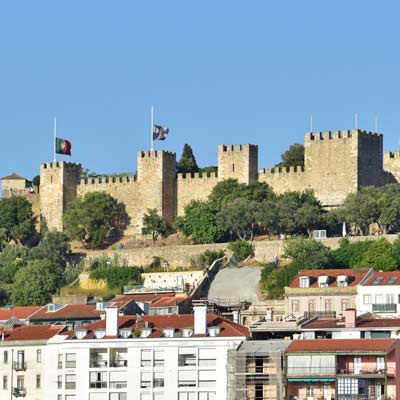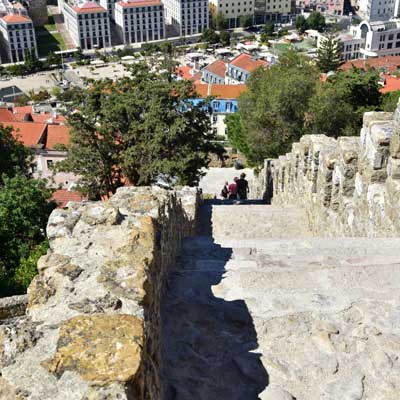LisbonLisboaPortugal.com
The best independent guide to Lisbon
LisbonLisboaPortugal.com
The best independent guide to Lisbon
The Castelo de São Jorge - Lisbon castle
The Castelo de São Jorge stands majestically above Lisbon and is one of the finest tourist attractions in the city.
The castle is entwined in Lisbon’s early history; it saw the fall of the Romans to the Visigoths, experienced the fierce conflicts between the Arabs and Christians, survived formidable sieges by the Castilians and witnessed the birth of Portugal as a seafaring nation.
This varied and turbulent history is reflected throughout the castle. There are heavily fortified battlements, medieval royal quarters and seaward views, which inspired exploration within Portuguese kings.
For visitors, the Castelo de São Jorge is a fascinating tourist attraction, and this is in part due to a major restoration performed in the 1940s. This project completely rebuilt the ramparts, embellished the watchtowers, and added tranquil gardens within the courtyards. The restoration may not be historically accurate, but it certainly enhances the visitor experience and provides you with a lot to discover within the complex.
Related articles: The Alfama district– Lisbon introduction – 48 hours in Lisbon
Highlights of the Lisbon Castle
A quick history of the Castelo de São Jorge
• 200bc – The castle was established by the Romans
• 480-714 - Visigoth rule of Portugal, and the castle was an important stronghold
• 714-1147 - North African Moors era, who strengthened the castle
• 1147 - Castle captured by the Christian Crusaders after a four-month siege by Afonso Henriques
• 1256 - The capital of Portugal is transferred from Coimbra to Lisbon, and the Castelo de São Jorge became the seat of power.
• 1305 - The Paço da Alcáçova (Royal Palace) is constructed
• 1373 - Failed siege by Castile (Spain)
• 1498 - After discovering the sea route to India, Vasco da Gama was received by King Manuel I in the castle
• 1522 - The Royal court is was moved to the Paço da Ribeira
• 1531 - Damaged by an earthquake
• Late 16th century - The castle had a lowly status, and was used as an arsenal and prison
• 1755 - Completely destroyed by a major earthquake, and was so unimportant that it was not rebuilt
• 1938 -1944 major restoration project under the Salazar government
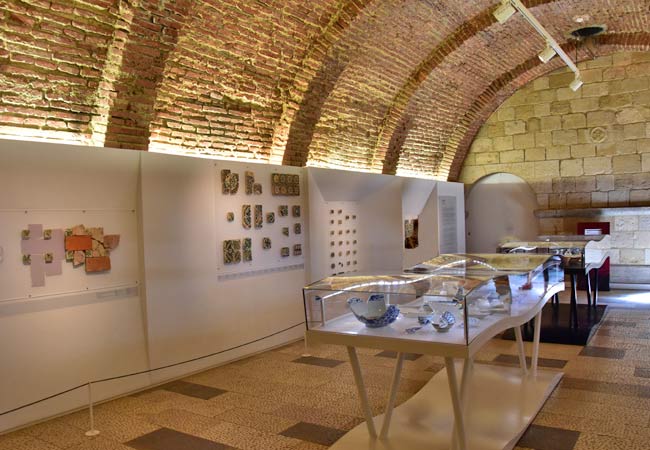
The museum displays artefacts found within the castle
Is the castle worth the entrance fee?
Admission to the Castelo de São Jorge is expensive costing €15.00 for adults, €7.50 for youths (aged 13–25), €12.50 for seniors (over 65), but is free for children under 12 years old.
Insider tip: Do not miss the pretty streets which are within the outer castle walls and around the Rua de Santa Cruz do Castelo
Why is the castle dedicated to Saint George?
One of the best ways to discover Lisbon and to meet fellow travellers is to join a guided tour. We have worked with Getyourguide.com for the last six years, and some of the best tours of Lisbon include:
The castle does get busy
Martim Moniz and the door…
The story of Martim Moniz is a fabled historic tale in Portuguese culture.
Martim Moniz was a Portuguese knight, who during the four-month siege of Lisbon castle, in 1147, was leading the attack on the castle when he spotted one of the side gates opened. He rushed ahead and wedged himself in the doorway, preventing the Moors from shutting the door.
This heroic action allowed the Christian Crusaders to storm and capture the castle, ending the siege. Martim Moniz was crushed to death but became a permanent legend in Portuguese culture.
The Martim Moniz gateway still exists, and is to the north of the castle complex, and from the gateway it overlooks the plaza of his name.
Things not to miss while in the castle
Inside of the Nucleo Museologico is a large drawing of Lisbon prior to the 1755 earthquake. This image is historical intresting, as it depicts the Se cathedral with a tower, the river side city walls and that the castle was the only building on top of the hill.
The Torre De Couraça is an exterior tower halfway down the hillside, which provided access to a second well and a means of reinforcing (or escaping the castle).
At the northeastern side of the castle complex are the agroecological excavations of the Moors Alcáçova, a residential area for the city’s political leaders and senior administrators. This site was extensively built upon and the excavations comprise three main eras: the Iron Age, the Moors period and early Christian Portugal.
The southern entrance into the castle, which crosses the stone bridge, was not the original medieval gateway and was only cut through the stone walls to connect the castle to the Paço da Alcáçova palace. The true gateway is much more heavily defended and is on the eastern side of the castle, facing the Moorish Alcáçova.
The castle’s defences were constructed to impede or trap attackers, with dead ends and indirect routes to the gates. This is best seen at the eastern entrance, as on entering the first wall the right path leads to a closed courtyard, and left route circles the inner wall to the second gateway.
Tourist facilities
There are good tourist facilities in the castle. There is a café and several kiosks where water, drinks or ice creams can be purchased. The restaurant within the castle, the Casa do Leão, has mixed reviews and to get the best service, avoid the peak hours of the day.
There are informative free tours, and if your visit to the castle coincides with one of these tours it is highly recommended to join.
The castle has attempted to provide disability access to the castle, with ramps and stairlifts, but the steep climb from the city centre along cobbled streets makes it challenging to get there. The toilets are of an acceptable level, and there are baby facilities.
Lisbon Castle History
The excellent vantage point of Castelo de São Jorge high above the River Tejo made it a prime defensive position and the site has been used since the Roman era. The reconstructed castle and battlements that can be viewed today are based on the layout from the 11th century and the introduction of Christianity to Portugal, as part of the second crusade. Before 1147 Lisbon was an important Moorish trading port with strong ties to North African heartland.
Afonso Henriques had answered the Popes call to “free the Holy Lands” as part of the second crusade and with his army drove the Moors from Lisbon and surrounding lands. The victory is romantically remembered as the liberation of Lisbon, but Alfonso’s mercenary army consisted of drunks and thieves, who once freed Lisbon from their slavery promptly sacked the city.
Afonso Henriques claimed the crown of Portugal and sensing a counter-attack from the Moors built the Castelo de São Jorge high on the defensive position. The fear of counterattack was incorporate into the design of the original castle, with the citadel the last line of defence. Successive kings of Portugal strengthened the defensive capabilities of Castelo de São Jorge to improve the survival chances of a frontal attack or extended siege.
The walls, cellars and wells were upgraded to withstand long sieges and defensive fortifications improved to make access difficult. The gradient leading to the main entrance was increased and a sharp 180-degree corner included preventing deployment of battering rams or cavalry charges. Other features which can still be found within the castle included; traitor gates, false doors and the entire surface with steps to provide maximum protection for defenders.
Discover more of Lisbon with our guides
If you've found our content valuable, we'd welcome your support.
The digital publishing landscape has evolved significantly. As a small independent publisher, we face growing challenges. Search engines increasingly favour paid content over organic results, while AI-generated content often reproduces original work without attribution.
To support our work, please consider bookmarking this page (press Ctrl + D) for quick access. If you find an article helpful, we'd be grateful if you'd share it with friends on social media.
For specific questions, please see our Reddit community at r/LisbonPortugalTravel.
Should you notice any outdated or incorrect information, please contact us at [email protected]
Thank you for helping us continue to provide valuable content in an increasingly challenging digital environment.
A complete list of all of our Lisbon articles
If you've found our content valuable, we'd welcome your support.
The digital publishing landscape has evolved significantly. As a small independent publisher, we face growing challenges. Search engines increasingly favour paid content over organic results, while AI-generated content often reproduces original work without attribution.
To support our work, please consider bookmarking this page (press Ctrl + D) for quick access. If you find an article helpful, we'd be grateful if you'd share it with friends on social media.
For specific questions, please see our Reddit community at r/LisbonPortugalTravel.
Should you notice any outdated or incorrect information, please contact us at [email protected]
Thank you for helping us continue to provide valuable content in an increasingly challenging digital environment.
